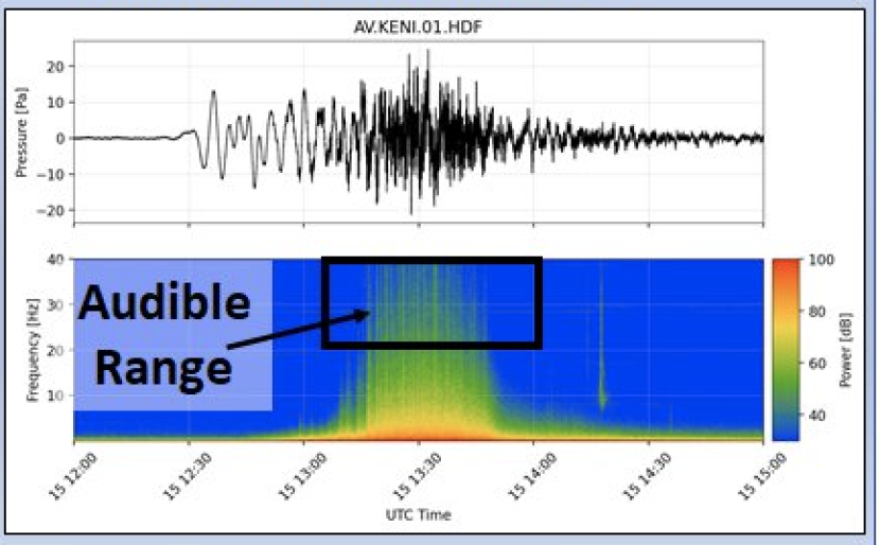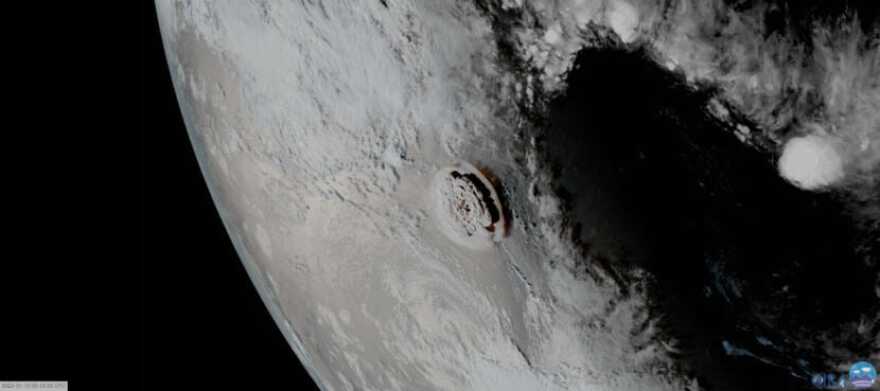Communities across the West Coast woke up Saturday morning to tsunami advisory alerts. An underwater volcano near the Kingdom of Tonga had erupted and sent waves thousands of miles across the ocean.
Waves of up to about three feet reached parts of Alaska by Saturday morning. But hours before those waves arrived, sounds from the blast reached the homes of many Alaskans — all the way from Juneau to the Aleutians.
Iris Caldentey and her kids were sleeping peacefully in their home early Saturday morning in Palmer when she woke up to loud, strange noises.
“How I would envision Pearl Harbor sounded — just constant, boom, boom, boom,” she said. “I mean, it was intense.”
Could it be avalanche control? A burglar? Maybe the kids bouncing off the walls? Like many people, Caldentey had no idea what she was hearing.
“I went outside to check the cars because then I was like, well, maybe there’s a burglar trying to get into our cars. And they’re opening, closing the door. Not a very good burglar,” she said.
In Unalaska, Laresa Syverson woke to similar sounds and vibrations.
“I thought for sure it was my cat — like, what’s my cat doing? So he got blamed for most of it,” she said.
First she thought her cat, then maybe fireworks, then she thought it could have just been bass coming from someone’s car.
While Syverson says she wasn’t immediately alarmed, neither she nor Caldentey would have guessed that the sounds were coming from an underwater volcano erupting near Tonga.
But that’s what it was — an eruption so massive it sent sound waves and a tsunami throughout the Pacific.
In Alaska, the largest tsunami waves hit the Aleutians and the Alaska Peninsula. King Cove recorded waves just over three feet. The tsunami destroyed property in Hawaii and Japan, caused flooding in California and killed two people when the waves reached Peru.
Syverson says she saw on social media that people had posted about hearing similar things — and that the booming sounds were from an eruption in the South Pacific.
“To be honest, I still didn’t even really believe it after that until I saw the satellite images of the actual eruptions. I was like, 'Oh, yeah, that’s probably what we were hearing,'” she said.
But how did so many Alaskans hear a sound from so far away? The short answer is that this volcanic blast was so big it traveled thousands of miles.
For the long answer, Ken Macpherson has some good insight. He’s a scientist at the Wilson Alaska Technical Center at the University of Alaska Fairbanks. The center has listening stations and seismic monitoring all over the world.
But usually they’re listening for something completely different — they’re monitoring the world for secret nuclear testing.
“And of course, those sensors are good at detecting things like nuclear bombs, but they’ll also pick up any kind of atmospheric blast of volcano being a good example,” Macpherson said.
He says they pick up all kinds of earthquakes and landslides and volcanic blasts. He slept right through this one, but he says the listening sensor in Fairbanks picked up the blast. And it’s interesting because those sensors are built for listening to frequencies that are lower than human hearing.
Think of it like a foghorn. They have this very low frequency sound.
“And the reason for that is a long period or low frequency signal like that will travel a longer distance. For higher frequencies, they attenuate,” Macpherson said. “That is, they just kind of get filtered out by the medium that they’re moving through.”
In other words, a higher-pitched sound won’t travel as far.

“But it looks like this Tonga blast was so big that even a high-frequency signal that’s audible to the human ear was able to travel almost 6,000 miles to Alaska and be heard widely across the state,” he said.
Data from UAF researchers clocks the sound wave from the blast moving at roughly 700 mph.
“And so it still took a long time to get to Alaska, because that’s almost 6,000 miles away,” Macpherson said. “But around eight hours after that huge explosion down in Tonga, those sound waves started to arrive in Alaska.”
He says if he hadn’t seen that data for himself, he’s not sure he’d believe it.
“And to be honest, when I first heard reports of this being heard, I was like, skeptical of that,” Macpherson said. “But it looks like it was possible to hear it. And the timing looks right. And so it does seem like it was widely heard across the state, which is just amazing.”
Macpherson says it’s scientifically interesting, but it’s important to keep the human toll of such an event in mind. What sounded like a loud boom to Alaskans can be devastating up close.
And the true toll on the people on the islands nearest to the volcano still isn’t clear. Communications with Tonga have been largely cut off since Friday. Surveillance flights showed significant damage to boats and buildings along the coastline. The country’s capital is covered in thick volcanic dust.
And many people around the world are still anxiously waiting to hear from friends and family on the islands.






